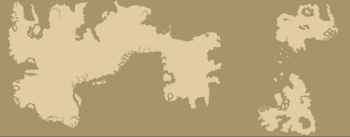Escandria
The Democratic Republic of Escandria La República Democrática de Escandria | |
|---|---|
Motto: 'Por la Democracia, Vivimos' 'For Democracy, We Live' | |
 | |
| Capital and largest city | Astugón |
| Official languages | Spanish |
| Religion (2020) |
|
| Demonym(s) | Escandrian |
| Government | Unitary semi-presidential constitutional republic |
| Alfonso Velasco Almánzar | |
| Octávia Montero Alamilla | |
| Legislature | Parliament |
| Chamber of the Senate | |
| Chamber of Representatives | |
| Independence from Spain | |
• Declared | 31 July 1515 |
| 25 December 1515 | |
| 24 May 1878 | |
| 3 August 1881 | |
| Area | |
• Total | 695.2 km2 (268.4 sq mi) |
| Population | |
• 2021 estimate | 1,236,940 |
| GDP (nominal) | 2020 estimate |
• Total | $70,379,521,290.85 |
• Per capita | $5,864.96 |
| Currency | Euro (EUR; €) |
| Time zone | UTC+2 |
| Date format | dd/mm/yyyy |
| Driving side | right |
| Calling code | +426 |
| Internet TLD | .ea |
The Democratic Republic of Escandria (Spanish: La República Democrática de Escandria) is an archipelagic island country situated in southern Europe, in the Mediterranean Sea. It consists of three islands: Santa Eulalia, San Jaime, and San Isidoro. Nearby countries include Malta and Italy to the north-west, Greece to the north and east, and Libya to the south. As of 2020, Escandria is estimated to have a population of approximately 1.2 million.
The islands have been inhabited since approximately 5000 BC, with settlers arriving from nearby Italy. Its location in the central Mediterranean has given it prominence as a strategic base for several world powers throughout history, including the Romans, Greeks, Arabs, French, Spanish, and others. The islands were a Spanish colony from 1435 until 1515, when the Escandrians broke free and established their own state. They then decided to establish their own monarchy, and after much debate, elected a new monarch, Spanish nobleman Juan Pablo Astugón de Palma, who ruled as King Juan I.
Centuries of authoritarian, and sometimes tyrannical, monarchy reigned over the Escandrian islands, leaving the general population to suffer in what can be described as a type of medieval serfdom. In the mid-to-late 19th Century, tensions between the people and the upper classes reached new heights, and the Escandrian Civil War broke out in 1874. Four long years of fighting and diplomacy ensued, with the Republicans ultimately winning out in 1878. The last monarch of Escandria, King Juan VI, and his family were exiled to Spain. The new government established the new “Democratic Republic” on May 24, 1878, in Astugón.
Present-day Escandria is a unitary, semi-presidential, constitutional republic. Since 1997, it has been a member state of the European Union, and in 2004, it officially adopted the Euro as its currency, replacing the former Veseta.
History
The islands have been inhabited since approximately 5000 BC, with settlers arriving from nearby Italy. Its location in the central Mediterranean has given it prominence as a strategic base for several world powers throughout history, including the Romans, Greeks, Arabs, French, Spanish, and others. The islands were a colony of the Spanish Empire from 1435 until 1515, when the Escandrians broke free and established their own state. They then decided to establish their own monarchy, and after much debate, elected a new monarch, Spanish nobleman Juan Pablo Astugón de Palma, who ruled as King Juan I.
Centuries of authoritarian, and sometimes tyrannical, monarchy reigned over the Escandrian islands, leaving the general population to suffer in what can be described as a type of medieval serfdom. In the mid-to-late 19th Century, tensions between the people and the upper classes reached new heights, and the Escandrian Civil War broke out in 1874. Four long years of fighting and diplomacy ensued, with the Republicans ultimately winning out in 1878. The last monarch of Escandria, King Juan VI, and his family were exiled to Spain. The new government established the new “Democratic Republic” on May 24, 1878, in Astugón.
Government
Escandria's head of state is the President of the Republic (Spanish: El Presidente de la República). Presidents of Escandria are elected every four years, directly- similarly to the presidential elections of the United States of America. Presidents are allowed to serve three terms although this has not yet been achieved. The role of the president is largely ceremonial, although some presidents have been known to take a more active political role.
Since November 11, 2017, the President of Escandria has been Alfonso Velasco Almánzar, who is nearing the end of his first term. The next Presidential Election is scheduled to be held on November 13, 2021.
The head of Escandria's government is the First Minister (Spanish: La Primera Ministra de Escandria). First Ministers are typically the leaders of the party who won the most seats nationally in the Escandrian Parliament elections. First Ministers do not have term limits, and serve for five years at a time.
Since March 1, 2018, the First Minister of Escandria has been Octávia Montero Alamilla, who is the leader of the Partido Democrático (Democratic Party). The next general election is scheduled to be held on March 20, 2023.
The Escandrian Parliament has two chambers- the Chamber of Representatives (Spanish: Cámara de Representantes; CR), and the Chamber of the Senate (Spanish: Cámara del Senado; CS). The CR has 500 seats, each representing a particular city/town/village/locality of the country. The CS has 150 seats, each representing a much larger area of the country.
The CR formulates laws, the CS operates balances and checks on the government and its activities, and the President then signs the final, approved laws into being.

